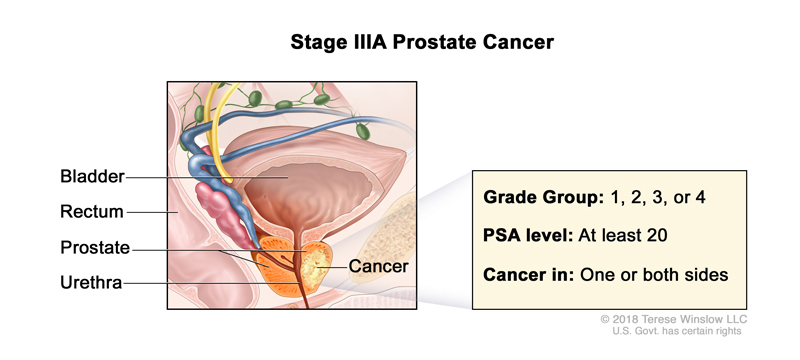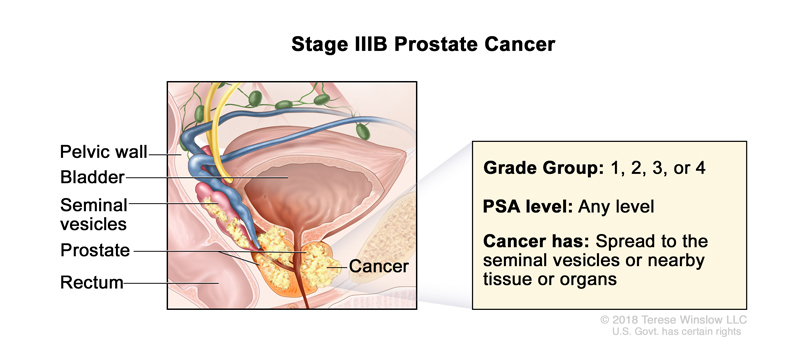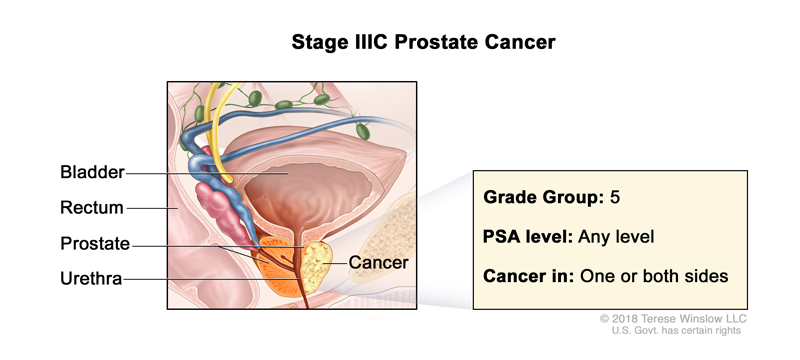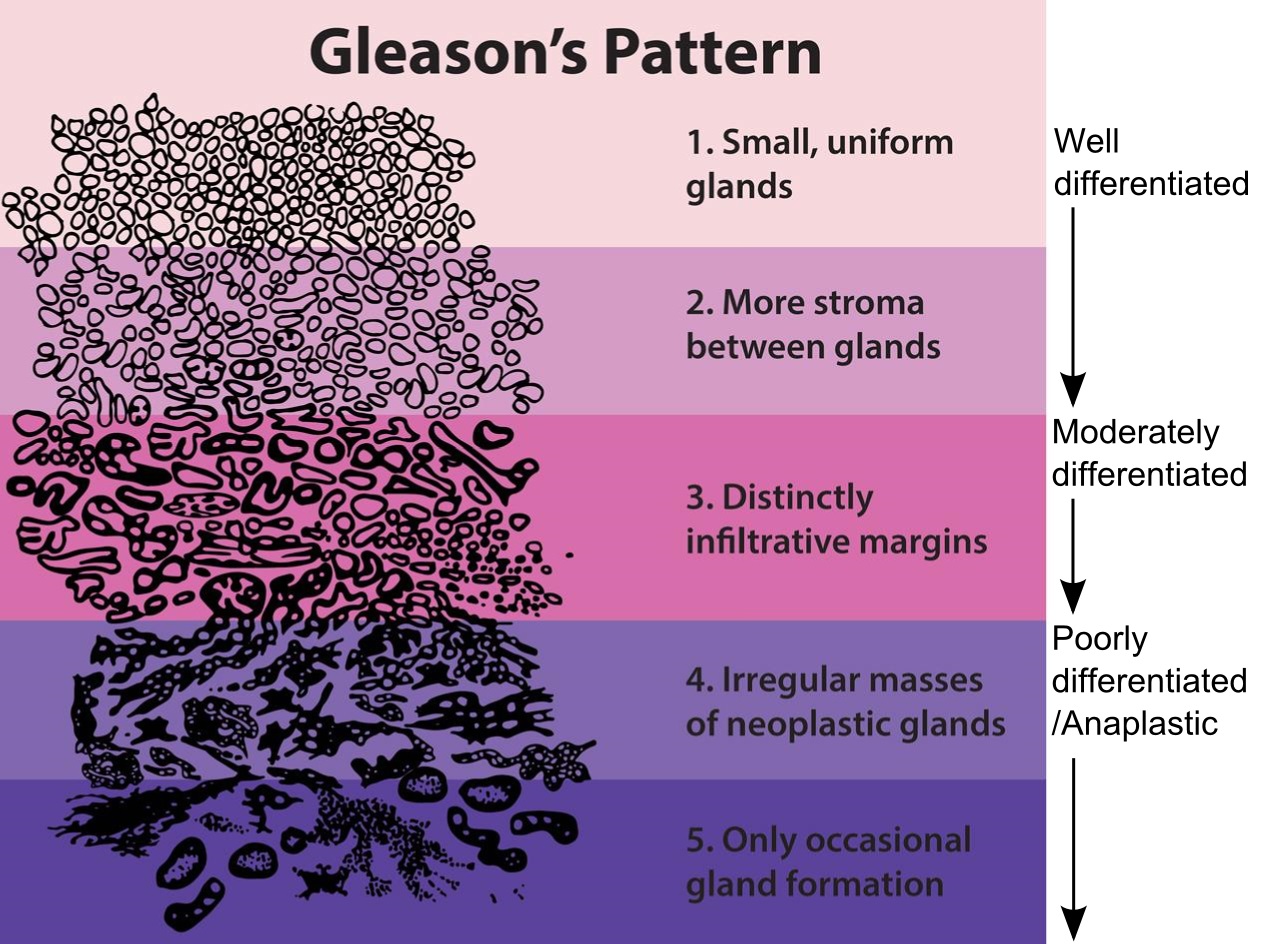Overview
Stage 3 Prostate Cancer is divided into 3 stages called 3A, 3B and 3C. Stage 3 Prostate Cancer refers to a locally advanced cancer, which means the cancer cells have spread from the site in which they were first found.
Understanding your Stage 3 Prostate Cancer diagnosis will help you and your doctors make the best treatment choice for you. Tap “Watch Now” for an easy-to-understand overview of Stage 3 Prostate Cancer.
- Stage 3A Prostate Cancer
- Stage 3B Prostate Cancer
- Stage 3C Prostate Cancer
- Gleason Score & PSA Explained
Overview
Stage 3A Prostate Cancer means that the tumor is affecting one or both sides of the prostate gland as shown here in yellow. It has not spread to your nearby lymph nodes or other organs in your body.
What Tests Will I Need and Why?
Blood and Imaging tests are done to understand your general health, confirm your diagnosis and determine your cancer stage.
Tissue Analysis is done to identify the cancer cell type and the Gleason Score, which is critical to finding the best treatment option for you.
With a Stage 3A Prostate Cancer diagnosis your PSA density is more than 20 and your Gleason Score is at any level. The Gleason Score is used by your doctors to determine the aggressiveness of the cancer.
You may also require special Saliva or Blood Analysis to look for specific mutations (actual changes in your body’s DNA), called BRCA1 and BRCA2.
Re-read this summary as needed and then tap, “Compare My Treatment Options Now“. Our unique Comparison Page will help you understand your FDA-approved treatment options including, who can help you pay for your treatment, where and how each is given and what side-effects you may experience.

Overview
A Stage 3B Prostate Cancer diagnosis means that the tumor has spread to the tissue surrounding your prostate or the glands that produce the fluids that will turn into semen, shown here in yellow. It has not spread to your nearby lymph nodes or to any other organs in your body.
It also means that your PSA can be at any level and any Gleason Score (Grade Group 1-4).
What Tests Will I Need and Why?
Blood and Imaging tests are done to understand your general health, confirm your diagnosis and determine your cancer stage.
Tissue Analysis is done to identify the cancer cell type and the Gleason Score, which is critical to finding the best treatment option for you.
You may also require special Saliva or Blood Analysis to look for specific mutations (actual changes in your body’s DNA), called BRCA1 and BRCA2.
Re-read this summary as needed and then tap, “Compare My Treatment Options Now“. Our unique Comparison Page will help you understand your FDA-approved treatment options including, who can help you pay for your treatment, where and how each is given and what side-effects you may experience.

Overview
A Stage 3C Prostate Cancer diagnosis means that the tumor is located in the prostate only or it is affecting the tissue surrounding the prostate or the glands that produce the fluids that will turn into semen. It has not spread to nearby lymph nodes or other organs.
What Tests Will I Need and Why?
Blood and Imaging tests are done to understand your general health, confirm your diagnosis and determine your cancer stage.
Tissue Analysis is done to identify the cancer cell type and the Gleason Score, which is critical to finding the best treatment option for you.
A Stage 3C diagnosis means that tissue analysis resulted in a Gleason Score of 10 on a scale of 1 to 10. A Gleason Score is used by your doctors to determine the aggressiveness of the cancer.
Stage 3C also means that the PSA can be at any level.
You may also require special Saliva or Blood Analysis to look for specific mutations (actual changes in your body’s DNA), called BRCA1 and BRCA2.
Re-read this summary as needed and then tap, “Compare My Treatment Options Now“. Our unique Comparison Page will help you understand your FDA-approved treatment options including, who can help you pay for your treatment, where and how each is given and what side-effects you may experience.

Gleason Score & PSA Density Explained
A Prostate Cancer diagnosis is based upon the results of staging and two tests called the Gleason Score and the prostate-specific antigen (PSA) tests
Finding Your Gleason Score
Samples of your cancer cells are examined to find out your Gleason Score. A Gleason Score, which will range between 2 and 10, describes how aggressive a prostate tumor is by looking at how similar or different the cancer cells look to healthy cells.
The Gleason Score is made up of 2 grades that range from 1 to 5. A low grade of 1 means that the cells in the tumor look very much like healthy prostate cells. Cells that look completely different to normal cells are assigned a higher score, usually 4 or 5.
- The first grade is given to describe the cells in the largest area of the tumor
- The second grade is given to describe the cells in the second largest area of the tumor.
When these two grades are added together, they give us a Gleason Score between 2 and 10. For example, 3+4 = Gleason Score 7.
Prostate-Specific Antigen (PSA) tests
Your Dr. also measures PSA Density to help determine the aggressiveness of the prostate cancer found. PSA Density is your PSA level, divided by the volume of the prostate gland.
A high PSA density is often a predictor of Prostate Cancer but please discuss your specific situation with your doctors.

Recommended Prostate Cancer Videos

Prostate Cancer
An Overview

Understanding Localized Prostate Cancer
An Overview

A Diagnosis and Treatment: Localized Prostate Cancer
A Conversation with Dr. John Lynch

Exercise & Prostate Cancer
From Your Friends @ the Oncology Nursing Society

How Cancer Spreads
Metastatic = Advanced
Commonly Searched Questions
What is the Survival Rate for Localized Prostate Cancer?
According to SEER data, Localized Prostate Cancer has a survival rate of 99%. For example, if the 5-year relative survival rate for the localized prostate cancer is 99%, it means that patients who have that cancer are, on average, about 99% as likely as patients who don’t have that cancer to live for at least 5 years after being diagnosed.
Source: Cancer.gov
What are the Treatment Options for Localized Prostate Cancer?
There are many treatments for localized prostate cancer. The type of treatment depends on many things. These may include your risk level, your age, and any other health problems. It is important to take time to learn about your cancer, your options for treatment, and possible side effects. Most men diagnosed with localized prostate cancer do not die from the disease.
Treatments for localized prostate cancer include:
- Watchful waiting
- Active surveillance
- Surgery to remove the prostate gland
- Radiation therapy
- Hormone therapy
Source: Effectivehealthcare.ahrq.gov
What is the definition of Localized Prostate Cancer?
Localized Prostate Cancer means that the cancer is located only in the prostate, it has not spread to any surrounding tissues, lymph nodes or distant organs.
Source: Cancer.ca
What are the Localized Prostate Cancer Symptoms?
Most men with localized prostate cancer have few or no symptoms. Possible symptoms can include:
- Problems when you urinate (such as pain or burning, difficulty starting or stopping, or a weak flow)
- Pain in your lower back
- Pain when you ejaculate
- Blood in your urine
Source: Effectivehealthcare.ahrq.gov
What are the risk factors for Localized Prostate Cancer?
The exact causes of prostate cancer aren’t known. Certain factors can increase the risk of prostate cancer somewhat. The main ones include:
-
Age: The risk of prostate cancer increases with age. This is the biggest risk factor.
-
Close relatives: Men who have a father or brother who developed prostate cancer are at a somewhat higher risk themselves. If several close relatives have (had) prostate cancer, your risk is even higher.
-
Ethnicity : Black men are somewhat more likely to develop prostate cancer.
-
Vitamin E: Dietary supplements that have a lot of vitamin E in them have been proven to increase the risk of prostate cancer if taken over many years.
Source: PubMed.gov
















